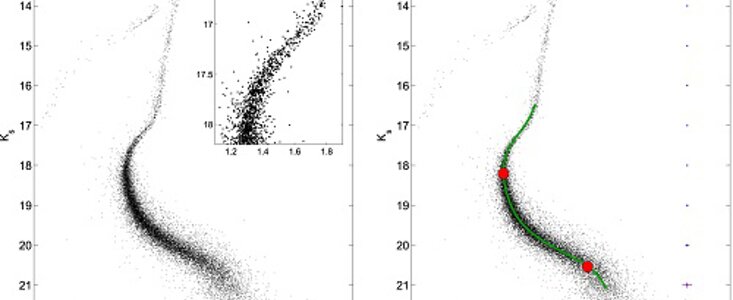The Deepest Ground-based Photometry in a Crowded Field
30 September 2015
Expecting to resolve stars deep into the crowded field of a globular cluster is a tall order for ground-based telescopes. However, Paolo Turri (University of Victoria, Canada) and colleagues have used the Gemini Multi-conjugate adaptive optics System (GeMS) with the Gemini South Adaptive Optics Imager (GSAOI) to do just that. Their data present the most accurate and deepest near-infrared photometry from the ground of a crowded field. It also illustrates the remarkable potential of MCAO-equipped Extremely Large Telescopes of the future.
Their Ks measurements of the Galactic globular cluster NGC 1851 are combined with HST photometry and the resulting color-magnitude diagram demonstrates that the ground-based data is of an unprecedented depth and precision for crowded field observations. The delivered image quality approaches Gemini’s diffraction limit, with an average measured full-width at half-maximum (FHWM) of 0.09 arcsecond.
Abstract:
The Extremely Large Telescopes currently under construction have a collecting area that is an order of magnitude larger than the present largest optical telescopes. For seeing-limited observations the performance will scale as the collecting area, but with the successful use of adaptive optics (AO), for many applications it will scale as D4 (where D is the diameter of the primary mirror). Central to the success of the ELTs, therefore, is the successful use of multi-conjugate adaptive optics (MCAO) which applies a high degree of correction over a field of view larger than the few arcseconds that limits classical AO systems. In this Letter, we report on the analysis of crowded field images taken on the central region of the galactic globular cluster NGC 1851 in the Ks band using the Gemini Multi-conjugate Adaptive Optics System (GeMS) at the Gemini South Telescope, the only science-grade MCAO system in operation. We use this cluster as a benchmark to verify the ability to achieve precise near-infrared photometry by presenting the deepest Ks photometry in crowded fields ever obtained from the ground. We construct a color–magnitude diagram in combination with the F606W band from the Hubble Space Telescope/Advanced Camera for Surveys. As well as detecting the “knee” in the lower main sequence at Ks '20.5, we also detect the double subgiant branch of NGC 1851, which demonstrates the high photometric accuracy of GeMS in crowded fields.
Links
- The work is published in The Astrophysical Journal Letters.


